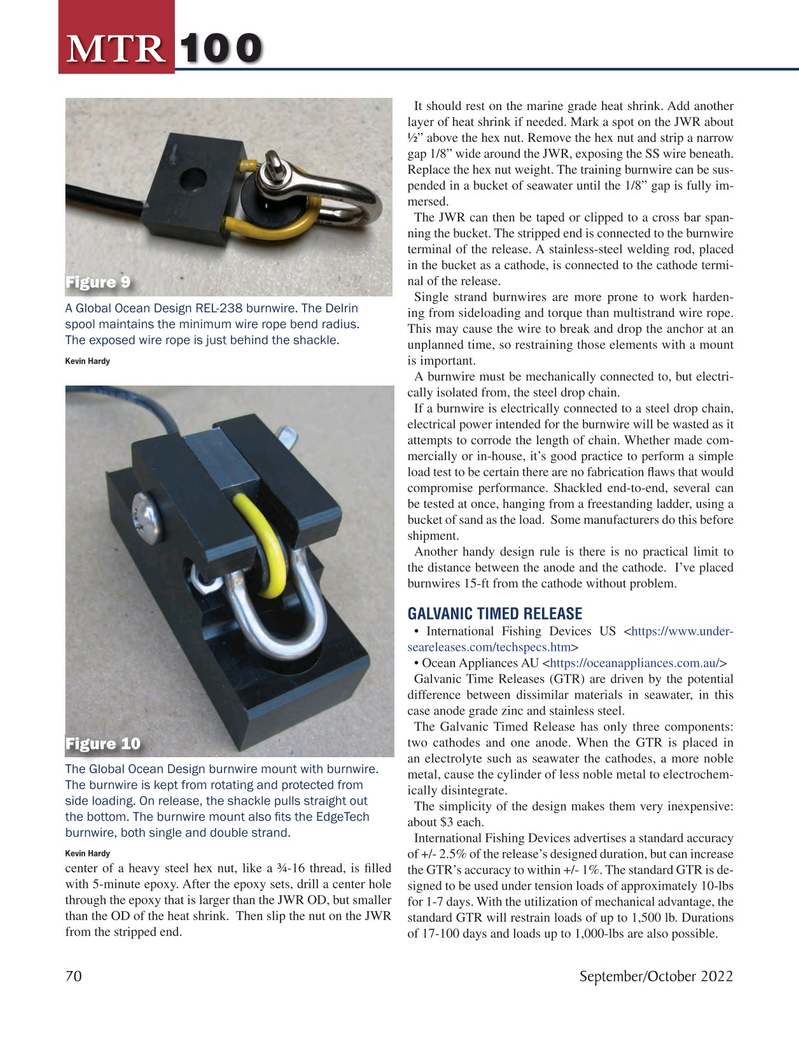
Page 70: of Marine Technology Magazine (September 2022)
Read this page in Pdf, Flash or Html5 edition of September 2022 Marine Technology Magazine
MTR 100
It should rest on the marine grade heat shrink. Add another layer of heat shrink if needed. Mark a spot on the JWR about ½” above the hex nut. Remove the hex nut and strip a narrow gap 1/8” wide around the JWR, exposing the SS wire beneath.
Replace the hex nut weight. The training burnwire can be sus- pended in a bucket of seawater until the 1/8” gap is fully im- mersed.
The JWR can then be taped or clipped to a cross bar span- ning the bucket. The stripped end is connected to the burnwire terminal of the release. A stainless-steel welding rod, placed in the bucket as a cathode, is connected to the cathode termi- nal of the release.
Figure 9
Single strand burnwires are more prone to work harden-
A Global Ocean Design REL-238 burnwire. The Delrin ing from sideloading and torque than multistrand wire rope. spool maintains the minimum wire rope bend radius.
This may cause the wire to break and drop the anchor at an
The exposed wire rope is just behind the shackle. unplanned time, so restraining those elements with a mount
Kevin Hardy is important.
A burnwire must be mechanically connected to, but electri- cally isolated from, the steel drop chain.
If a burnwire is electrically connected to a steel drop chain, electrical power intended for the burnwire will be wasted as it attempts to corrode the length of chain. Whether made com- mercially or in-house, it’s good practice to perform a simple load test to be certain there are no fabrication ? aws that would compromise performance. Shackled end-to-end, several can be tested at once, hanging from a freestanding ladder, using a bucket of sand as the load. Some manufacturers do this before shipment.
Another handy design rule is there is no practical limit to the distance between the anode and the cathode. I’ve placed burnwires 15-ft from the cathode without problem.
GALVANIC TIMED RELEASE • International Fishing Devices US
Galvanic Time Releases (GTR) are driven by the potential difference between dissimilar materials in seawater, in this case anode grade zinc and stainless steel.
The Galvanic Timed Release has only three components: two cathodes and one anode. When the GTR is placed in
Figure 10 an electrolyte such as seawater the cathodes, a more noble
The Global Ocean Design burnwire mount with burnwire. metal, cause the cylinder of less noble metal to electrochem-
The burnwire is kept from rotating and protected from ically disintegrate. side loading. On release, the shackle pulls straight out
The simplicity of the design makes them very inexpensive: the bottom. The burnwire mount also ? ts the EdgeTech about $3 each.
burnwire, both single and double strand.
International Fishing Devices advertises a standard accuracy
Kevin Hardy of +/- 2.5% of the release’s designed duration, but can increase center of a heavy steel hex nut, like a ¾-16 thread, is ? lled the GTR’s accuracy to within +/- 1%. The standard GTR is de- with 5-minute epoxy. After the epoxy sets, drill a center hole signed to be used under tension loads of approximately 10-lbs through the epoxy that is larger than the JWR OD, but smaller for 1-7 days. With the utilization of mechanical advantage, the than the OD of the heat shrink. Then slip the nut on the JWR standard GTR will restrain loads of up to 1,500 lb. Durations from the stripped end. of 17-100 days and loads up to 1,000-lbs are also possible. 70 September/October 2022
MTR #7 (66-79).indd 70 9/28/2022 7:14:52 PM

 69
69

 71
71
